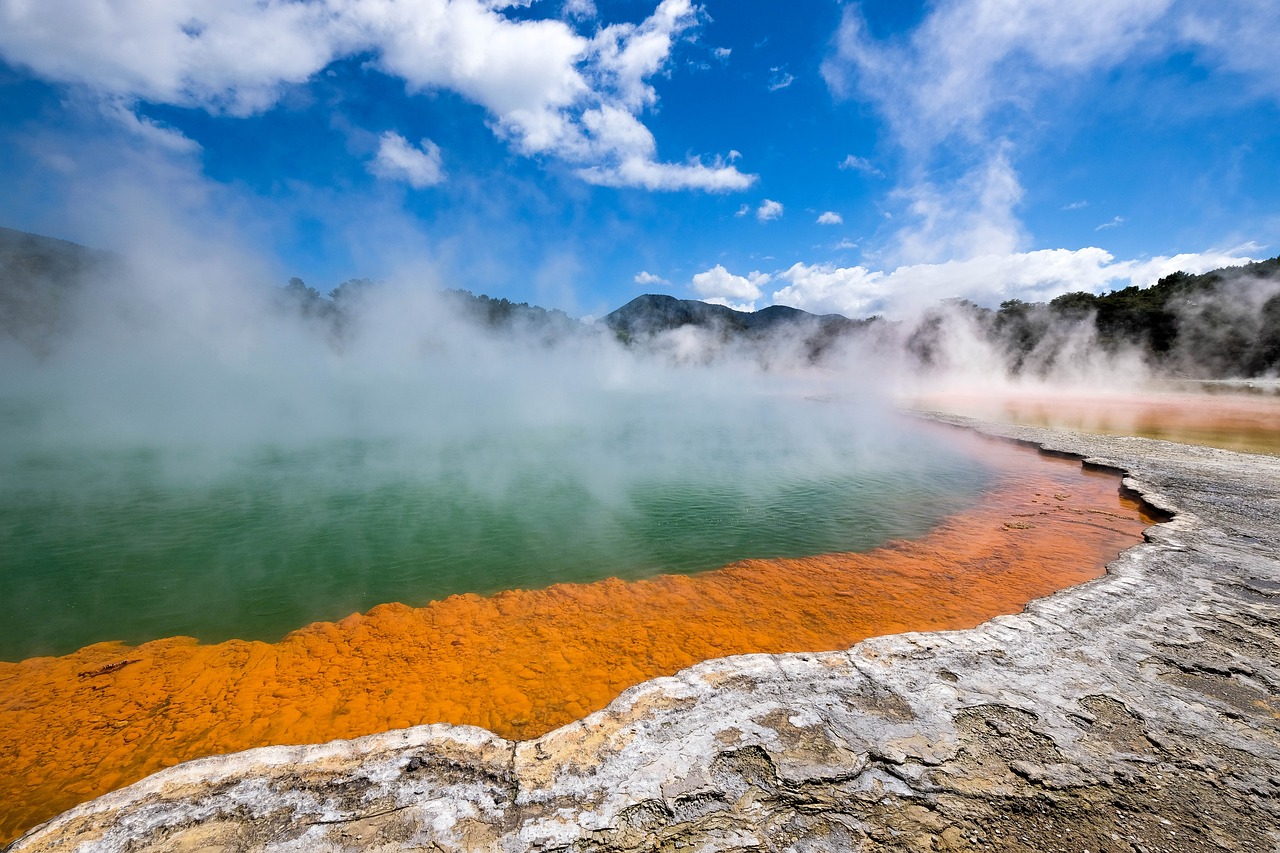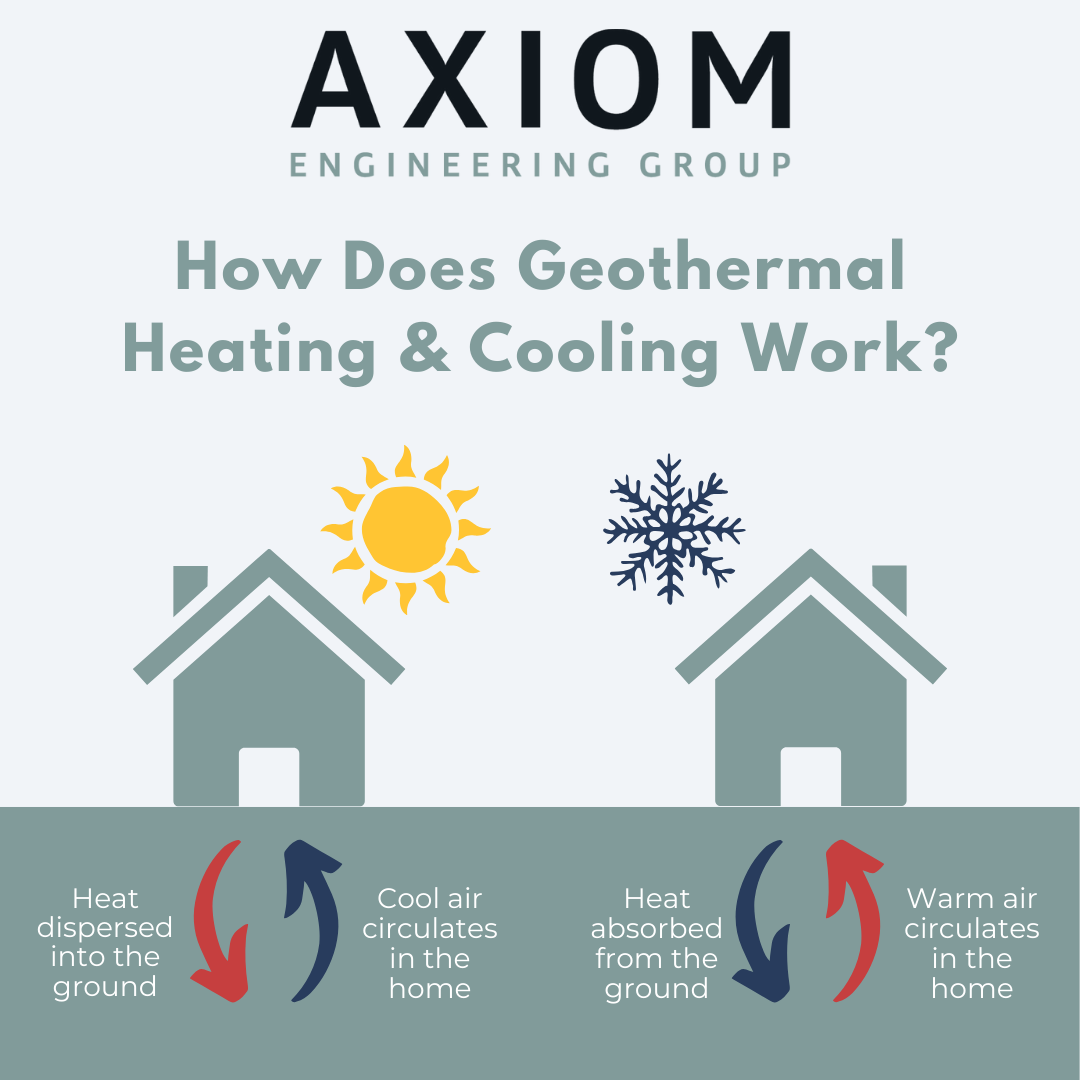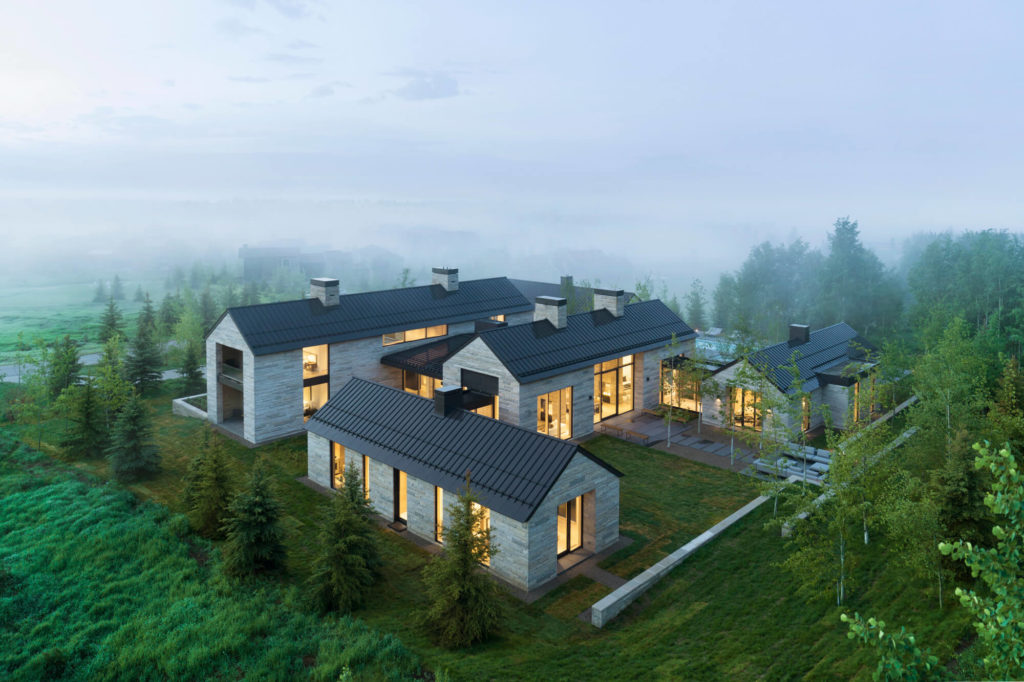As summer temperatures soar, staying cool becomes a top priority. Whether at home or work, maintaining an efficient cooling system is crucial for enjoying the summer heat without discomfort. Ready to enjoy everything these hot months have to offer with an eco-friendly and cost-conscious cooling system? That’s where geothermal cooling comes into play.
At Axiom Engineering Group, we’re passionate about providing our clients with reliable, sustainable, and cost-effective solutions to maintain the perfect temperature all year round. Geothermal cooling is one of our top recommendations for clients looking to harness the power of the earth to manage temperatures in their homes or businesses efficiently. Whether the vision is air conditioning that is so quiet that you barely notice it’s there, or the ability to take hot showers back-to-back in frigid winter weather, our team loves to craft the best system for the needs of every client we collaborate with.
What is Geothermal Cooling?

Let’s start by breaking down what the word “geothermal” means:
Derived from the Greek “geo” and “therme”, geothermal translates directly to “earth heat”, referring to the continual production of heat from the Earth’s core.
Merriam-Webster, 2024.
In addition to the geothermal phenomena we can witness above ground (think hot springs, geysers, and volcanoes), there is a constantly renewable source of geothermal resources underground, depending on the location. The most prolific of these are electricity generation using geothermal energy and the utilization of underground temperatures to heat and cool the area above. Based on the temperature above ground, a geothermal system can function as a heat “sink”, which absorbs the heat during warmer months, and a heat “source”, which provides heat during cooler months.
How Does Geothermal Cooling Work?
Geothermal cooling systems work by transferring heat from your building into the ground, utilizing the earth’s consistent underground temperatures. This process not only cools your space effectively, but also provides a flexible and reliable system for year-round climate control. Unlike traditional air conditioning systems that depend on external temperatures and energy sources, geothermal cooling takes advantage of the Earth’s natural temperature stability – this means lower energy costs and less environmental impact.
In a geothermal system, a loop of pipes buried in the ground acts as a heat exchanger, transferring temperature between the earth and the building. But how? The ground is warmer than the air during the winter, and is cooler than the above-ground air in the summer. Imagine this: it’s a hot and sticky July day, and not even being indoors gives respite from the sweat-inducing temperature and humidity. But fear not – With a geothermal system, the heat from inside the building is absorbed and transferred into the underground loop without the noise and delay of a typical air conditioning unit. The cooler earth absorbs the heat, and the geothermal heat pump uses the cold temperatures found underground to create cool, dehumidified air that is then transferred back into the building.

Types of Geothermal Systems
A ground loop is the heart of a geothermal system and is crucial to the efficiency of geothermal cooling. There are two main types of ground loops:
- Closed Loop: In a closed-loop system, the same liquid continuously circulates through the buried pipes, exchanging heat with the ground.
- Open Loop: In contrast, open-loop systems draw water from a nearby source, such as a well or pond, and return it after heat exchange.
Both types of ground loops are designed to maximize the transfer of heat to the ground, but the choice between them depends on the specific site conditions and cooling requirements. The heat pump, located inside the building, works in conjunction with the ground loop to control the heat exchange process. In cooling mode, the heat pump absorbs the warm air from the building’s interior, transfers it to the liquid in the ground loop, and sends cooler air back into the home. This process is incredibly efficient because the temperature difference between the indoor air and the underground environment is smaller than with outdoor air, allowing the system to use less energy than traditional air conditioning units.
Why Choose Geothermal Cooling?
1. Environmental Impacts
One of the most compelling reasons to choose geothermal cooling is the reduced environmental impact and carbon footprint. Traditional heating and cooling systems contribute significantly to carbon emissions -residential heating and cooling alone account for over 10% of the United States’ carbon emissions and 40% of its annual energy usage (University of Michigan, 2023). In contrast, geothermal systems produce zero carbon emissions during operation, making them a greener choice for temperature regulation.
Reports from the U.S. Department of Energy (DOE) and the International Ground Source Heat Pump Association (IGSHPA) indicate that switching to geothermal from a traditional system can reduce up to 75% of a home’s carbon emissions. Because geothermal systems function by moving existing heat around, opposed to generating it, the energy used in heating and cooling is also significantly lower.
2. Federal & State Incentives
Much of the world is embracing the notable sustainability impacts of geothermal heating and cooling, and the United States is no exception. As early as 2005, the federal government began efforts to incentivize home and business owners to consider pursuing geothermal over traditional systems. From significant tax credits to financial assistance programs and grants for home energy, weatherization efforts, and technical maintenance, there are various federal and state resources that encourage folks across the U.S. to choose clean energy systems like geothermal heating and cooling. A particularly incentivizing program targets homeowners that install a geothermal heat pump, and offers a weighty return on the costs of the system:
Homeowners are eligible for a 30% tax credit under the Inflation Reduction Act (IRA) Residential Energy Efficient Property Credit (Section 25D) for ENERGY STAR-rated GHPs that are in service by Jan. 1, 2033.
Department of Energy, 2024 | Tax Credits, Incentives, and Technical Assistance for Geothermal Heat Pumps
In addition to geothermal systems, DOE incentives are available for various sustainable building upgrades, such as solar electricity and water heating, energy-efficient appliances, and updates to electrical equipment. While the eligibility and requirements vary across the United States, many home and business owners are taking advantage of the various programs encouraging the installation and use of clean energy systems like geothermal cooling. To find out more about your state’s energy programs and incentives, check out the DOE’s list of State Energy Offices and Organizations.
3. Efficiency, Reliability, and Cost Savings
Beyond sustainability efforts and incentive programs, geothermal cooling also offers numerous benefits once the system is installed: efficiency, reliability, and cost savings. Traditional heating and cooling systems that rely on electricity or gas are subject to outages, potential damage and leaks, and unpredictable price increases. Geothermal systems, on the other hand, provide consistent operation and stable costs, so users are never without comfortable temperatures or blindsided by inflated costs and recurring maintenance.
But how are geothermal cooling systems able to remain so reliable and efficient throughout the year (and its fluctuating temperatures)?
Efficiency
Firstly, geothermal cooling is highly efficient because it moves heat rather than generating it. Traditional air conditioners use a significant amount of energy to compress and cool refrigerant, while geothermal systems rely on the earth’s natural thermal energy. The earth’s stable temperatures make it easier to transfer heat away from your home, reducing the amount of electricity required to achieve the same level of cooling – talk about efficiency!
Reliability
Additionally, geothermal systems do not rely on fluctuating outdoor temperatures, which makes them particularly effective in extreme climates where traditional systems may struggle to keep up. The underground environment provides a constant, reliable source for heat exchange, ensuring consistent heating and cooling performance throughout the whole year. With a geothermal system, gone are the days of hoping you have enough hot water for a relaxing shower on a winter day, or that the A/C will be able to keep the whole house cool when summer temperatures peak. At Axiom, we believe that essential comforts like reliable heating and cooling are nonnegotiable; That’s why we strive to provide our clients with expertly designed systems that they’ll never have to second guess.
Cost Savings
Lastly, while the initial investment for designing and installing a geothermal system is typically higher than installing a traditional system, the long-term savings on energy bills and maintenance is substantial. Studies from the DEO and United States Environmental Protection Agency (EAP) report average energy cost saving of up to 50%, and as the price of utility operation continues to rise across the U.S., these savings will likely continue to increase for geothermal system users. In addition to the significant reduction in operation costs, geothermal users also enjoy less fluctuation when it comes to those necessary fees – Here at Axiom Engineering Group, we strive to provide consistency across the board to our clients, and that includes budgeting for pesky repair and maintenance costs. Geothermal systems typically require significantly less maintenance and upkeep than traditional heating and cooling systems, which eliminates the surprise flood of repair bills when something inevitably malfunctions. Geothermal systems are designed and built to last, and the DOE reports that the underground elements typically have a life expectancy of 25-50 years!

Interested in Geothermal Cooling Systems?
Whether you’re seeking reliable temperature control year-round, aiming to reduce your utility and maintenance costs, or striving to implement environmentally conscious systems in your building, geothermal cooling could be the perfect solution for your project!
At Axiom Engineering Group, we specialize in designing geothermal systems that meet the unique needs of our clients, whether it’s for new constructions or retrofitting existing buildings. We’ve partnered with countless architects, homeowners, and business owners to create customized geothermal systems that deliver unmatched efficiency and sustainability. Our expertise ensures that your geothermal system is designed to provide optimal comfort, cost savings, and year-round efficiency – all while reducing the impact on the planet.
Contact Us Today!
Learn more about geothermal systems with Axiom Engineering Group today! Our team of experienced and creative engineers are standing by to discuss the system options that are right for you and your project. For more information and to bring your vision to life, give us a call at (406) 542-2849 or email our team at connect@aeg.design. Learn more about who we are and what we do on our website, and check out our other articles and blog posts for even more great information across countless industry topics.
Stay cool, save money, and go green with geothermal cooling! And choose the experts at Axiom for all of your engineering needs.
Sources
- Center for Sustainable Systems, University of Michigan. 2023. “U.S. Energy System Factsheet”.
- International Ground Source Heat Pump Association, 2024. “Benefits of Geothermal”.
- United States Department of Energy, 2024. “Geothermal Heat Pumps”, “Geothermal Technologies Office – Geothermal Basics”.
- United States Environmental Protection Agency, 2024. “Impact Assessment for Geothermal Systems”.
Published September 10th, 2024, Shannon Frizzell.
